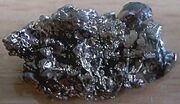
Barium is a chemical element with the symbol Ba and atomic number 56.
Barium is a soft silvery metallic alkaline earth metal. Its oxide is historically known as baryta but it reacts with water and carbon dioxide and is not found as a mineral. The most common naturally occurring minerals are the very insoluble barium sulphate, BaSO4 (barite), and barium carbonate, BaCO3 (witherite). Barium's name originates from Greek barys (βαρύς), meaning "heavy", describing the high density of some common barium-containing ores.
Metallic barium has few industrial uses, but has been historically used to scavenge air in vacuum tubes. Barium compounds impart a green color to flames and have been used in fireworks. Barium sulphate is used for its heaviness, insolubility, and X-ray opacity. It is used as an insoluble heavy mud-like paste when drilling oil wells, and in purer form, as an X-ray radio contrast agent for imaging the human gastrointestinal tract. Soluble barium compounds are poisonous due to release of the soluble barium ion, and have been used as rodenticides. New uses for barium continue to be found: it is an essential ingredient in "high temperature" YBCO superconductors.
Characteristics[]
Barium is a soft and ductile metal. Its simple compounds are notable for their relatively high (for an alkaline earth element) specific gravity. This is true of the most common barium-bearing mineral, its sulphate barite BaSO4, also called 'heavy spar' due to the high density (4.5 g/cm³).
Barium reacts exothermically with oxygen at room temperature to form barium oxide and peroxide. The reaction is violent if the barium is powder, it also reacts violently with dilute acids, alcohol and water.
At elevated temperatures, barium combines with chlorine, nitrogen and hydrogen to produce BaCl2, Ba3N2 and BaH2, respectively.
Barium combines with several metals, including aluminium, zinc, lead and tin, forming intermetallic compounds and alloys.
Value[]
The base value of each unit of ranges between 10 and 20Ð per unit, with up to 3 units being found at any one time.
Presence on Mars: Rare
| Martian Minerals | |
| Group 1 | Group 2 | Group 3 | Group 4 | Group 5 | Group 6 | |
| Group 3 | |Antimony | Astatine | Barium | Bismuth | Cesium | Francium | Hafnium | Indium | Iodine | Iridium | Lanthanum | Lead | Mercury | |Osmium | Platinum | Polonium | Radium | Radon | Rhenium | Tantalum | Tellurium | Thallium | Tin | Tungsten | Xenon| |